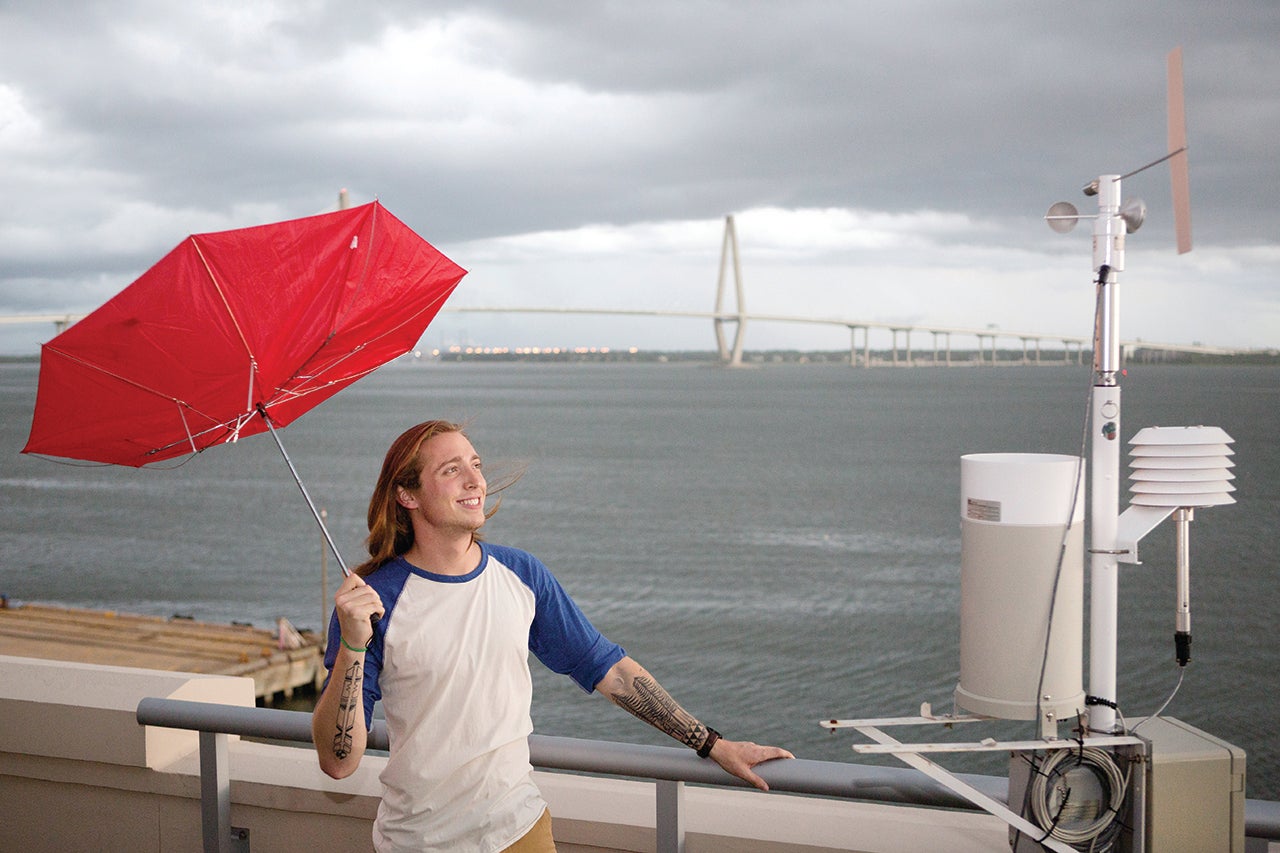Synergy. That’s what interests Lance Foxworth. As a senior, he’s focusing much of his academic work on the way natural phenomena such as weather and ocean activity influence and affect one another. Though you may not find Foxworth quoting Aristotle, he’s well aware of the notion that “the whole is greater than the sum of its parts.” That concept, in fact, is what’s driving him these days as he prepares to graduate with distinction as one of the first students at the College to obtain a degree in meteorology.
The College is the first university in South Carolina to offer an undergraduate degree in meteorology, but that’s not what drew Foxworth here. Actually, that major didn’t exist when he first enrolled three years ago. At the time, he planned to study political science, along with French. Then, he took some introductory geology courses and became captivated by the subject matter. That led him to take “Introduction to Meteorology,” and he was fully hooked.
“Through that course,” Foxworth explains, “I realized that the scope of what makes up meteorology goes way beyond what I had previously thought. We studied how large-scale physical phenomena are interconnected. It all made perfect sense to me. So right then – as a sophomore– I knew I’d be taking a bunch more meteorology courses.”
Foxworth recalls sitting down with professors in the geology and environmental geosciences department (geology is his other major) to discuss where this new field might lead him. “Right off the bat, they disabused me of the idea that meteorology majors only become weather forecasters,” he says. “They talked about exciting opportunities such as seafloor mapping because they knew I was interested in marine geology. But they told me that it’s difficult to understand the sea without understanding the atmosphere. Ultimately, they convinced me that so much of what goes on in one major system is influenced by others. All of that helped me understand how getting a grounding in meteorology would enhance my work in marine geology.”
And that’s just what Foxworth has been doing. While pursuing his coursework in meteorology, he joined geology professor Leslie Sautter’s Benthic Acoustic Mapping and Survey Program (BEAMs) and began working to develop a predictive model for finding a particular deep-sea coral habitat.
“The sites I’ve been focused on,” he says, “are in the Papahānaumokuākea Marine National Monument, which is halfway between Hawaii and Midway Atoll. There are coral species there unique to that habitat. And finding these really specific and niche species allows me to use my marine geology, but it also allows me to apply meteorological science to consider why certain sides of these islands have more corals than others. That involves understanding the wind patterns that cross over the ocean’s surface at those sites. Those patterns can determine which side of the coral mounds ocean upwelling will take place on, and that upwelling brings up the nutrients that feed various species. So, it’s clear that this work involves looking at the earth, looking at the ocean and looking at the atmosphere because they each play into what I’m apt to find.”
It may seem that Foxworth is specializing in the intersection of meteorology and marine geology, but his studies have been extremely varied. For example, along with three fellow students, he took on an ambitious project to develop an earthquake primer for the South Carolina Emergency Management Division.
“Professor Norm Levine brought this opportunity to us,” explains Foxworth. “The commission wanted something that they could use to inform students in public schools about the basics of earthquakes. So, we developed a web-based, GIS-driven story map. Teachers in K-12 schools now use it to teach about earthquakes. And our entry-level geology courses at the College are using it, as well.”
Foxworth and his team didn’t stop there. They augmented the primer by developing a self-guided walking tour of earthquake-related sites in Charleston. “For the tour,” he says, “we researched historic buildings and found archived images of them before and after substantial quakes. We identified elements such as the pattress plates (earthquake plates) and indicated how wooden buildings in the same sector of town all lean in the same direction because of the impact of a quake. The tour is mobile friendly, so anyone who wants to can pull it up on their phone and scroll through the information as they take the tour.”
More recently, Foxworth traveled to South Africa for a field-study course. He and 11 other students garnered insights about climate history by examining sediments and fossils at various sites around the country. “We looked at paleo climate and then considered the modern-day environmental conditions and how they tie in together,” he explains. “Our intent is to learn how the changes in the past affect what’s going on today. We also added to this mix some contemporary cultural and government factors, and we’re now trying to understand how those affect all of this.”
For his final year, Foxworth’s academic agenda will be typically protean. He’ll be taking at least three courses in GIS, working as a docent for the College’s Mace Brown Museum of Natural History and serving as a teaching assistant for a minerology-petrology course. On top of that, he hopes to sign on and work with geology professor Ian Rumsey, whose research is focused on natural and anthropogenic pollutants (i.e., pollution caused by people). “In one project,” says Foxworth, “he’s measuring and evaluating the deposition of nitrogen, sulphur and hydrocarbons. It’s actually the perfect project for me because it deals with the interaction between the surface biosphere and geosphere and the atmosphere.”
In a word, it’s all about synergy.





